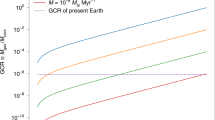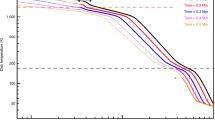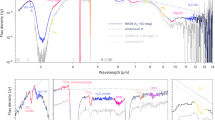Abstract
Empirical constraints of fundamental properties of protoplanetary disks are essential for understanding planet formation and planetary properties1,2. Carbon monoxide (CO) gas is often used to constrain disk properties3. However, estimates show that the CO gas abundance in disks is depleted relative to expected values4,5,6,7, and models of various disk processes impacting the CO abundance could not explain this depletion on observed ~1 Myr timescales8,9,10,11,12,13,14. Here we demonstrate that surface energy effects on particles in disks, such as the Kelvin effect, that arise when ice heterogeneously nucleates onto an existing particle can efficiently trap CO in its ice phase. In previous ice formation models, CO gas was released when small ice-coated particles were lofted to warmed disk layers. Our model can reproduce the observed abundance, distribution and time evolution of gaseous CO in the four most studied protoplanetary disks7. We constrain the solid and gaseous CO inventory at the midplane and disk diffusivities and resolve inconsistencies in estimates of the disk mass—three crucial parameters that control planetary formation.
This is a preview of subscription content, access via your institution
Access options
Access Nature and 54 other Nature Portfolio journals
Get Nature+, our best-value online-access subscription
$29.99 / 30 days
cancel any time
Subscribe to this journal
Receive 12 digital issues and online access to articles
$119.00 per year
only $9.92 per issue
Buy this article
- Purchase on Springer Link
- Instant access to full article PDF
Prices may be subject to local taxes which are calculated during checkout




Similar content being viewed by others
Data availability
Code availability
The numerical models used in this work are not public. However, they are available from the corresponding author upon reasonable request.
References
Pollack, J. B. et al. Formation of the giant planets by concurrent accretion of solids and gas. Icarus 124, 62–85 (1996).
Öberg, K. I., Murray-Clay, R. & Bergin, E. A. The effects of snowlines on C/O in planetary atmospheres. Astrophys. J. Lett. 743, L16 (2011).
Andrews, S. M. Observations of protoplanetary disk structures. Annu. Rev. Astron. Astrophys. 58, 483–528 (2020).
Ansdell, M. et al. ALMA survey of Lupus protoplanetary disks. I. Dust and gas masses. Astrophys. J. 828, 46 (2016).
Bergin, E. A. et al. An old disk still capable of forming a planetary system. Nature 493, 644–646 (2013).
Schwarz, K. R. et al. The radial distribution of H2 and CO in TW Hya as revealed by resolved ALMA observations of CO isotopologues. Astrophys. J. 823, 91 (2016).
Zhang, K., Bergin, E. A., Schwarz, K., Krijt, S. & Ciesla, F. Systematic variations of CO gas abundance with radius in gas-rich protoplanetary disks. Astrophys. J. 883, 98 (2019).
Zhang, K., Schwarz, K. R. & Bergin, E. A. Rapid evolution of volatile CO from the protostellar disk stage to the protoplanetary disk stage. Astrophys. J. Lett. 891, L17 (2020).
Bergner, J. B. et al. An evolutionary study of volatile chemistry in protoplanetary disks. Astrophys. J. 898, 97 (2020).
Dodson-Robinson, S. E. et al. Ionization-driven depletion and redistribution of CO in protoplanetary disks. Astrophys. J. Lett. 866, 2 (2018).
Schwarz, K. R. et al. Unlocking CO depletion in protoplanetary disks. I. The warm molecular layer. Astrophys. J. 856, 85 (2018).
Krijt, S., Schwarz, K. R., Bergin, E. A. & Ciesla, F. J. Transport of CO in protoplanetary disks: consequences of pebble formation, settling, and radial drift. Astrophys. J. 864, 1 (2018).
Krijt, S. et al. CO depletion in protoplanetary disks: a unified picture combining physical sequestration and chemical processing. Astrophys J. 899, 134 (2020).
Yu, M., Evans, N. J., Dodson-Robinson, S. E., Willacy, K. & Turner, N. J. Disk masses around solar-mass stars are underestimated by CO observations. Astrophys. J. 841, 39 (2017).
Zhang, K., Bosman, A. D. & Bergin, E. A. Excess C/H in protoplanetary disk gas from icy pebble drift across the CO snowline. Astrophys. J. Lett. 891, L16 (2020).
Flaherty, K. M. et al. A three-dimensional view of turbulence: constraints on turbulent motions in the HD 163296 protoplanetary disk using DCO+. Astrophys. J. 843, 150 (2017).
Flaherty, K. M. et al. Turbulence in the TW Hya disk. Astrophys. J. 856, 117 (2018).
Flaherty, K. M. et al. Measuring turbulent motion in planet-forming disks with ALMA: a detection around DM Tau and nondetections around MWC 480 and V4046 Sgr. Astrophys. J. 895, 109 (2020).
Powell, D., Murray-Clay, R. & Schlichting, H. E. Using ice and dust lines to constrain the surface densities of protoplanetary disks. Astrophys. J. 840, 93 (2017).
Powell, D., Murray-Clay, R., Pérez, L. M., Schlichting, H. E. & Rosenthal, M. New constraints from dust lines on the surface densities of protoplanetary disks. Astrophys. J. 878, 116 (2019).
Franceschi, R. et al. Mass determination of protoplanetary disks from dust evolution. Astron. Astrophys. 657, 74 (2021).
McClure, M. K. et al. Mass measurements in protoplanetary disks from hydrogen deuteride. Astrophys. J. 831, 167 (2016).
Lacy, J. H., Knacke, R., Geballe, T. R. & Tokunga, A. T. Detection of absorption by H2 in molecular clouds: a direct measurement of the H2:CO ratio. Astrophys. J. Lett. 428, L69-72 (1994).
Ballering, N. P., Cleeves, L. I. & Anderson, D. E. Simulating observations of ices in protoplanetary disks. Astrophys. J. 920, 115 (2021).
Konopacky, Q. M. et al. Detection of carbon monoxide and water absorption lines in an exoplanet atmosphere. Science 339, 1398–1401 (2013).
Barman, T. S. et al. Simultaneous detection of water, methane, and carbon monoxide in the atmosphere of exoplanet HR8799 b. Astrophys. J. 804, 62 (2015).
Lavie, B. et al. HELIOS-RETRIEVAL: an open-source, nested sampling atmospheric retrieval code; application to the HR 8799 exoplanets and inferred constraints for planet formation. Astron. J. 154, 91 (2017).
Wang, J. et al. On the chemical abundance of HR 8799 and the planet c. Astrophys. J. 160, 150 (2020).
Powell, D., Zhang, X., Gao, P. & Parmentier, V. Formation of silicate and titanium clouds on hot Jupiters. Astrophys. J. 860, 18 (2018).
Gao, P., Marley, M. S. & Ackerman, A. S. Sedimentation efficiency of condensation clouds in substellar atmospheres. Astrophys. J. 855, 86 (2018).
Birnstiel, T., Klahr, H. & Ercolano, B. A simple model for the evolution of the dust population in protoplanetary disks. Astron. Astrophys. 539, A148 (2012).
Lambrechts, M. & Johansen, A. Forming the cores of giant planets from the radial pebble flux in protoplanetary discs. Astron. Astrophys. 572, A107 (2014).
Chen, J.-P., Hazra, A. & Levin, Z. Parameterizing ice nucleation rates using contact angle and activation energy derived from laboratory data. Atmos. Chem. Phys. 8, 7431–7449 (2008).
Campbell, J. M., Meldrum, F. C. & Christenson, H. K. Observing the formation of ice and organic crystals in active sites. Proc. Natl Acad. Sci. USA 114, 810–815 (2017).
Nachbar, M. et al. Laboratory measurements of heterogeneous CO2 ice nucleation on nanoparticles under conditions relevant to the Martian mesosphere. J. Geophys. Res. Planets 121, 753–769 (2016).
Pruppacher, H. R. and Klett, J. D. Microphysics of Clouds and Precipitation (Kluwer, 1997).
Määttänen, A., Vehkamäki, H., Lauri, A., Napari, I. & Kulmala, M. Two-component heterogeneous nucleation kinetics and an application to Mars. J. Chem. Phys. 127, 134710 (2007).
Wood, S. E. Nucleation and Growth of Carbon Dioxide Ice Crystals in the Martian Atmosphere. Ph.D. thesis, Univ. of California, Los Angeles (1999).
Fletcher, N. H. Size effect in heterogeneous nucleation. J. Chem. Phys. 29, 572–576 (1958).
Fletcher, N. H. The Physics of Rainclouds (Cambridge Univ. Press, 1962).
Hobbs, P. V. Ice Physics (Oxford, Clarendon, 1974).
Campbell, J. M. & Christenson, H. K. Nucleation- and emergence-limited growth of ice from pores. Phys. Rev. Lett. 120, 165701 (2018).
Holden, M. A., Campbell, J. M., Meldrum, F. C., Murray, B. J. & Christenson, H. K. Active sites for ice nucleation differ depending on nucleation mode. Proc. Natl Acad. Sci. USA 118, e2022859118 (2021).
Hakimian, A. et al. Freezing of few nanometers water droplets. Nat. Commun. 12, 6973 (2021).
Laffon, C. et al. Laboratory-based sticking coefficients for ices on a variety of small-grain analogues. Nat. Astron 5, 445–450 (2021).
Cleeves, L. I. et al. The ancient heritage of water ice in the solar system. Science 345, 1590–1593 (2014).
Cooke, I. R. et al. CO diffusion and desorption kinetics in CO2 ices. Astrophys. J. 852, 75 (2018).
Wylie, L. The Vapor Pressure of Solid Argon, Carbon Monoxide, Methane, Nitrogen, and Oxygen from Their Triple Points to the Boiling Point of Hydrogen. Thesis, Georgia Institute of Technology (1958).
Hill, R. Nucleation of thin films. Nature 210, 512–513 (1966).
Pathak, H., Mullick, K., Tanimura, S. & Wyslouzil, B. E. Nonisothermal droplet growth in the free molecular regime. Aerosol Sci. Technol. 47, 1310–1324 (2013).
Zhang, X., Pandis, S. N. & Seinfeld, J. H. Diffusion-limited versus quasi-equilibrium aerosol growth. Aerosol Sci. Technol. 46, 874–885 (2012).
Bogdan, A. Ice clouds: atmospheric ice nucleation concept versus the physical chemistry of freezing atmospheric drops. J. Phys. Chem. A 122, 7777–7781 (2018).
Leger, A., Gauthier, S., Defourneau, D. & Rouan, D. Properties of amorphous H2O ice and origin of the 3.1-micron absorption. Astron. Astrophys. 117, 164–169 (1983).
Leger, A., Jura, M. & Omont, A. Desorption from interstellar grains. Astron. Astrophys. 144, 147–160 (1985).
Ros, K. et al. Effect of nucleation on icy pebble growth in protoplanetary discs. Astron. Astrophys. 629, 65 (2019).
Shakura, N. I. & Sunyaev, R. A. Black holes in binary systems. Observational appearance. Astron. Astrophys. 24, 337 (1973).
Hartmann, L., Calvet, N., Gullbring, E. & D’Alessio, P. Accretion and the evolution of T Tauri disks. Astrophys. J. 495, 385–400 (1998).
Stevenson, D. J. & Lunine, J. I. Rapid formation of Jupiter by diffusive redistribution of water vapor in the solar nebula. Icarus 75, 146–155 (1988).
Cuzzi, J. N. & Zahnle, K. J. Material enhancement in protoplanetary nebulae by particle drift through evaporation fronts. Astrophys. J. 614, 490–496 (2004).
Ciesla, F. J. & Cuzzi, J. N. The evolution of the water distribution in a viscous protoplanetary disk. Icarus 181, 178–204 (2006).
Schoonenberg, D. & Ormel, C. W. Planetesimal formation near the snowline: in or out? Astron. Astrophys. 602, A21 (2017).
Booth, R. A., Clarke, C. J., Madhusudhan, N. & Ilee, J. D. Chemical enrichment of giant planets and discs due to pebble drift. Mon. Not. R. Astron. Soc. 469, 3994–4011 (2017).
Birnstiel, T., Andrews, S. M., Pinilla, P. & Kama, M. Dust evolution can produce scattered light gaps in protoplanetary disks. Astrophys. J. Lett. 813, L14 (2015).
Calahan, J. K. et al. The TW Hya Rosetta Stone Project. III. Resolving the gaseous thermal profile of the disk. Astrophys. J. 908, 8 (2021).
Chiang, E. I. & Goldreich, P. Spectral energy distributions of T Tauri stars with passive circumstellar disks. Astrophys. J. 490, 368–376 (1997).
Xu, R., Bai, X.-N. & Öberg, K. Turbulent-diffusion mediated CO depletion in weakly turbulent protoplanetary disks. Astrophys. J. 835, 162 (2017).
Mawet, D. et al. Direct imaging of extra-solar planets in star forming regions. Astron. Astrophys. 544, A131 (2012).
Pegues, J. et al. An ALMA survey of H2CO in protoplanetary disks. Astrophys. J. 890, 142 (2020).
Simon, M., Dutrey, A. & Guilloteau, S. Dynamical masses of T Tauri stars and calibration of pre-main-sequence evolution. Astrophys. J. 545, 1034 (2000).
Ribas, Á., Hervé, B. & Bruno, M. Protoplanetary disk lifetimes vs. stellar mass and possible implications for giant planet populations. Astron. Astrophys. 576, 52 (2015).
Law, C. J. et al. Molecules with ALMA at Planet-forming Scales (MAPS). III. Characteristics of radial chemical substructures. Astrophys. J. Suppl. Ser. 257, 3 (2021).
Huang, J. et al. CO and dust properties in the TW Hya disk from high-resolution ALMA observations. Astrophys. J. 852, 122 (2018).
Nomura, H. et al. ALMA observations of a gap and a ring in the protoplanetary disk around TW Hya. Astrophys. J. Lett. 819, L7 (2016).
Williams, J. P. & McPartland, C. Measuring protoplanetary disk gas surface density profiles with ALMA. Astrophys. J. 830, 32 (2016).
Booth, A. S. et al. The first detection of 13C17O in a protoplanetary disk: a robust tracer of disk gas mass. Astrophys. J. Lett. 882, L31 (2019).
Bosman, Arthur D. et al. Molecules with ALMA at planet-forming scales (MAPS). XV. Tracing protoplanetary disk structure within 20 au. Astrophys. J. Supplementary Series 257, 15 (2021).
Zhang, K. et al. Mass inventory of the giant-planet formation zone in a solar nebula analogue. Nat. Astron 1, 0130 (2017).
Law, C. J. et al. Molecules with ALMA at Planet-forming Scales (MAPS). IV. Emission surfaces and vertical distribution of molecules. Astrophys. J. Suppl. Ser. 257, 4 (2021).
Kataoka, A. et al. Opacity of fluffy dust aggregates. Astron. Astrophys. 568, A42 (2014).
Ardila, D. R. et al. Hot gas lines in T Tauri stars. Astrophys. J. Suppl. Ser. 207, 1 (2013).
Kama, M. et al. Volatile-carbon locking and release in protoplanetary disks—a study of TW Hya and HD 100546. Astron. Astrophys. 592, A83 (2016).
Acknowledgements
We acknowledge K. Öberg for her feedback on the surface binding properties of CO ice, S. Andrews for his insightful discussion of the outer radii of disks as measured from CO emission and J. Szulagyi for insightful discussions about the temperature structures in protoplanetary disks. This work benefited from the Exoplanet Summer Program in the Other Worlds Laboratory at the University of California, Santa Cruz, a program funded by the Heising–Simons Foundation. D.P. acknowledges support from the Ford Foundation Dissertation Year Fellowship Program and support from NASA (the National Aeronautics and Space Administration) through the NASA Hubble Fellowship grant HST-HF2-51490.001-A awarded by the Space Telescope Science Institute, which is operated by the Association of Universities for Research in Astronomy, Inc., for NASA, under contract NAS5-26555. D.P. and R.M.C. acknowledge support from NSF CAREER grant number AST-1555385. R.M.C and X.Z. acknowledge support from NASA Interdisciplinary Consortia for Astrobiology Research (ICAR) grant 80NSSC21K0597. P.G. acknowledges support from the 51 Pegasi b Fellowship sponsored by the Heising–Simons Foundation and support from NASA through the NASA Hubble Fellowship grant HST-HF2-51456.001-A awarded by the Space Telescope Science Institute, which is operated by the Association of Universities for Research in Astronomy, Inc., for NASA, under contract NAS5-26555. X.Z. acknowledges support from the NASA Solar System Workings Grant 80NSSC19K0791 and the NASA Exoplanet Research Grant 80NSSC22K0236. D.P. is an NHFP Sagan Fellow.
Author information
Authors and Affiliations
Contributions
D.P., P.G. and R.M.C. conceived of the project. D.P. and P.G. adapted the microphysical model of CO ice formation. D.P. coupled the radial model to the microphysical ice modelling and wrote the manuscript. D.P. and R.M.C. conceived of the concepts used in the model coupling. D.P., X.Z. and R.M.C. conceived several useful tests of the finished model. All authors provided comments used in editing the manuscript.
Corresponding author
Ethics declarations
Competing interests
The authors declare no competing interests.
Peer review
Peer review information
Nature Astronomy thanks Edwin Bergin, Colette Salyk and the other, anonymous, reviewer(s) for their contribution to the peer review of this work
Additional information
Publisher’s note Springer Nature remains neutral with regard to jurisdictional claims in published maps and institutional affiliations.
Supplementary information
Supplementary Information
Supplementary Figs. 1–4 and Tables 1–2.
Rights and permissions
About this article
Cite this article
Powell, D., Gao, P., Murray-Clay, R. et al. Depletion of gaseous CO in protoplanetary disks by surface-energy-regulated ice formation. Nat Astron 6, 1147–1155 (2022). https://doi.org/10.1038/s41550-022-01741-9
Received:
Accepted:
Published:
Issue Date:
DOI: https://doi.org/10.1038/s41550-022-01741-9



